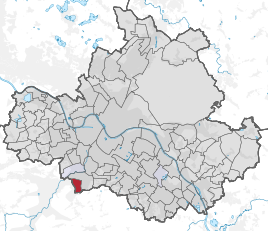Grid lake
|
Grid lake
District of the state capital Dresden
Coordinates: 51 ° 0 ′ 33 ″ N , 13 ° 41 ′ 26 ″ E
|
|
|---|---|
| Height : | 180–280 m above sea level NN |
| Incorporation : | July 1, 1945 |
| Postal code : | 01189 |
| Area code : | 0351 |
|
Location of the Gittersee district in Dresden
|
|
Gittersee is a district of the Saxon state capital Dresden . Together with Coschütz, it forms the statistical district of Coschütz / Gittersee in the Plauen district . Gittersee is best known for the uranium mining that took place there.
geography
Gittersee is located south of Dresden city center on the outskirts. The city of Freital joins it to the south . Gittersee is somewhat elevated to about 270 m above sea level. NN east of the Plauen reason , a valley of the Weißeritz .
history
The origin of the name Gittersee is not, as one might assume at first glance, Germanic. Rather, Gittersee was first mentioned as Geterssin and is of Sorbian origin, the meaning could be "Dawn".
Gittersee was owned by the von Miltitz family until 1370 and then passed to the Dresden Bridge Office . In addition to the usual arable use, fruit growing on the northern slope of the Dresden Elbe valley also found favorable conditions in Gittersee .
The Gitterseer coal Building Association began in 1828 with the mining of coal , which was discontinued after the company's bankruptcy in 1859 again. Local self-government was introduced in 1839, for which the community built the town hall on Karlsruher Straße, which was used until 1945 .
On July 1, 1945, Gittersee was incorporated into Dresden. In 1950, the VEB Steinkohlenwerk Freital devastated a new double shaft system at the train station, on which mining on hard coal was operated again until 1967. Thereafter, the mine continued to be operated by SDAG Wismut until 1989 as the “Willy Agatz” mining company for the extraction of uranium ores. In the south of the neighboring district of Coschütz is the Coschütz / Gittersee industrial area , which is located on the former site of the uranium factory 95 , a uranium ore processing plant.
From 1945 which entered the inn of Gittersee Volksoper Dresden (from 1949 State Opera of Saxony ), which in 1950 by Radebeul moved and out of in the 1950s by fusion with the country's acting the Saxony Theater were. The Gorbitzer DEFA studio for animated films maintained a recording studio in Gittersee.
In connection with the social changes, Gittersee played a significant role with the planned construction of the Gittersee high- purity silicon plant and the initially spontaneous citizen protests, which were initially unheard of in the GDR, the protagonists of which ultimately formed a large part of the core of the group of 20 over several intermediate steps .
Personalities
- Wilhelm Lachnit (1899–1962), painter
- Max Lachnit (1900–1972), architect and sculptor
Attractions

The museum on the history of the Windbergbahn has been located in a building at Gittersee station since 1988 . The still existing section of the Windbergbahn from Freital-Ost to Gittersee was opened at the end of 2008 by the Saxon Museumseisenbahn Verein Windbergbahn e. V., which operates special trains on the route and wants to run a museum after its renovation. On the former section from Gittersee, a hiking trail has been created that follows the route via Kleinnaundorf to Bannewitz and Possendorf .
See also
Web links
- dresdner-stadtteile.de
- Gittersee in the Digital Historical Directory of Saxony


